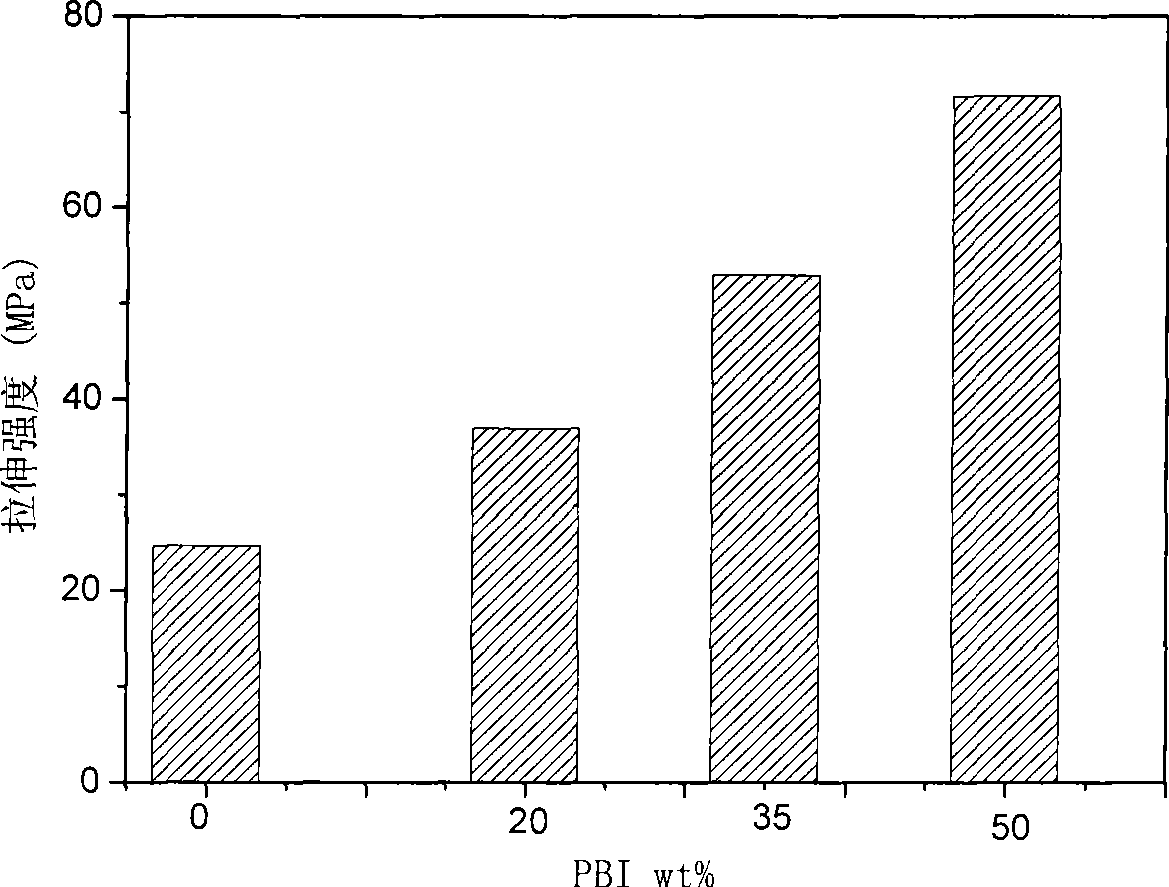Enhancement type composite proton exchanging film based on semi-interpenetrating network
A proton exchange membrane and semi-interpenetrating network technology, applied in the field of enhanced composite proton exchange membrane and its preparation, can solve the problems of insufficient mechanical properties, expensive use, low dynamic life, etc.
- Summary
- Abstract
- Description
- Claims
- Application Information
AI Technical Summary
Problems solved by technology
Method used
Image
Examples
Embodiment 1
[0049] The ratio of raw materials used is as follows:
[0050] 1 part of PBI-ph (number of moles of repeating units)
[0051] Resin 0.2 parts (number of moles of repeating units)
[0052] Sodium hydride 4 parts (moles)
[0053] 1 part of 4-chloromethylstyrene (moles)
[0054] 1 part of styrene (number of moles)
[0055] N, N-dimethylacetamide 500 parts (moles)
[0056] Azobisisobutyronitrile 0.8 part (moles)
[0057] Preparation method of composite membrane:
[0058] 1) Add 0.1g The resin was soaked in a sodium hydroxide solution with a mass concentration of 10% for 22 hours, then taken out and dried to constant weight, and then dissolved in 20ml of N,N-dimethylacetamide at 180°C to form a uniform solution.
[0059] 2) Dissolve 0.4g (1.3mmol) of PBI-ph in 20ml of N,N-dimethylacetamide at 160°C to form a brown homogeneous solution. Then, under the protection of nitrogen at 80°C, 5.2 mmol of sodium hydride was added to the PBI-ph solution, and the reaction was continu...
Embodiment 2
[0066] The ratio of raw materials used is as follows:
[0067] 1 part of PBI-ph (number of moles of repeating units)
[0068] Resin 0.8 parts (repeating unit moles)
[0069] Sodium hydride 4 parts (moles)
[0070] Chloromethylethylene 0.2 parts (moles)
[0071] 0.2 parts of divinylbenzene (number of moles)
[0072] 160 parts of N-methylpyrrolidone (moles)
[0073] Azobisisobutyronitrile 0.05 parts (moles)
[0074] Preparation method of composite membrane:
[0075] 1) Add 0.4g After soaking in 10% sodium hydroxide solution for 24 hours, take it out and dry it to constant weight, then dissolve it in 5ml N-methylpyrrolidone at 160°C to form a uniform solution.
[0076] 2) Dissolve 0.4g (1.3mmol) of PBI-ph in 5ml of N-methylpyrrolidone at 140°C to form a brown homogeneous solution. Then, at 80° C., under the protection of nitrogen, 5.2 mmol of sodium hydride was added to the PBI-ph solution, and the reaction was continuously stirred for 24 hours. Then, 0.41 mmol of chl...
Embodiment 3
[0082] The ratio of raw materials used is as follows:
[0083] 1 part of PBI-ph (number of moles of repeating units)
[0084] 9 parts of resin (number of moles of repeating units)
[0085] Sodium hydride 4 parts (moles)
[0086] 1 part of 4-chloromethyl styrene (number of moles)
[0087] Vinyl tetrazole 0.5 parts (moles)
[0088] 500 parts of N-methylpyrrolidone (moles)
[0089] 1 part of dibenzoyl peroxide (number of moles)
[0090] Preparation method of composite membrane:
[0091] 1) Add 2.25g After soaking in 10% sodium hydroxide solution for 24 hours, take it out and dry it to constant weight, then dissolve it in 22ml of N,N-dimethylacetamide at 160°C to form a uniform solution.
[0092] 2) Dissolve 0.2g (0.65mmol) of PBI-ph in 20ml of N,N-dimethylacetamide at 160°C to form a brown homogeneous solution. Then, at 80° C., under the protection of nitrogen, 2.6 mmol of sodium hydride was added to the PBI-ph solution, and the reaction was continuously stirred for 24...
PUM
 Login to View More
Login to View More Abstract
Description
Claims
Application Information
 Login to View More
Login to View More - R&D
- Intellectual Property
- Life Sciences
- Materials
- Tech Scout
- Unparalleled Data Quality
- Higher Quality Content
- 60% Fewer Hallucinations
Browse by: Latest US Patents, China's latest patents, Technical Efficacy Thesaurus, Application Domain, Technology Topic, Popular Technical Reports.
© 2025 PatSnap. All rights reserved.Legal|Privacy policy|Modern Slavery Act Transparency Statement|Sitemap|About US| Contact US: help@patsnap.com

